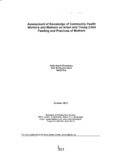| dc.contributor.author | Chowdhury, Anita Sharif | |
| dc.contributor.author | Islam, Qazi Shafayetul | |
| dc.contributor.author | Roy, Sanjit | |
| dc.date.accessioned | 2019-12-03T04:30:07Z | |
| dc.date.available | 2019-12-03T04:30:07Z | |
| dc.date.issued | 2013-10 | |
| dc.identifier.citation | Chowdhury, A. S., lslam, Q. S., & Roy, S. (2013, October). Assessment of knowledge of community health workers and mothers on infant and young child feeding and practices of mothers. Research Reports (2013): Health Studies, Vol - XLV, 1–21. | en_US |
| dc.identifier.uri | http://hdl.handle.net/10361/13172 | |
| dc.description.abstract | Poor infant feeding practices are some of major causes of under-nutrition in children
under five years of age in Bangladesh. In order to address the issue, BRAC ·has
implemented the Alive and Thrive (A&T) programme to promote adequate infant and
young child feeding (IYCF) practices in rural Bangladesh. The programme had already
been in operation in 22 upazilas in nine districts for more than one-and a half years
before the time of the survey (October 2011). We tried to understand the level of
knowledge and practices of mothers in IYCF in A& T programme areas. In addition, the
study also investigated the Shashthya Shebikas' (SS) (health volunteer) knowledge of
IYCF. The study was a post-test cross-sectional study to compare areas with and
without A & T intervention as no baseline data was available. Both structured and
semi-structured tools were used to collect information. The respondents were: women
with children aged under one year (n=1 ,224) and SSs (n=120). Findings reveal that
both mothers and SSs had reasonably good knowledge of breast-feeding. For
example, 95% of mothers knew about colostrum feeding and the duration of exclusive
breast-feeding (without water). Breast-feeding practice was commendable as 89% of
mothers fed colostrum immediately after birth, moreover, 75% of mothers practised
exclusive breast-feeding. Gapes in knowledge were found regarding the types as well
as the nature of complementary food among both mothers and SSs. For example,
gaps in knowledge existed in offering age appropriate food, in the frequency of serving
and in the quantity to be served to children under one year. In conclusion, it can be
said that A& T had progressed well in terms of some important IYCF indicators such as
breast-feeding practices. However, it more effort needs to be given to improve
complementary feeding practices. | en_US |
| dc.language.iso | en | en_US |
| dc.publisher | BRAC Research and Evaluation Division (RED) | en_US |
| dc.subject | Community health workers | en_US |
| dc.subject | Mother | en_US |
| dc.subject | BRAC | en_US |
| dc.subject | Infants | en_US |
| dc.subject.lcsh | Infants -- Nutrition. | |
| dc.subject.lcsh | Breastfeeding. | |
| dc.subject.lcsh | Community health services -- Bangladesh. | |
| dc.title | Assessment of knowledge of community health workers and mothers on infant and young child feeding and practices of mothers | en_US |
| dc.type | Research report | en_US |

